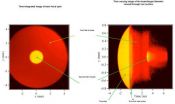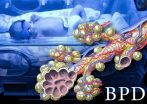'Brain waves' challenge area-specific view of brain activity
2013-03-20
(Press-News.org) Our understanding of brain activity has traditionally been linked to brain areas – when we speak, the speech area of the brain is active. New research by an international team of psychologists led by David Alexander and Cees van Leeuwen (KU Leuven – University of Leuven) shows that this view may be overly rigid. The entire cortex, not just the area responsible for a certain function, is activated when a given task is initiated. Furthermore, activity occurs in a pattern: waves of activity roll from one side of the brain to the other.
The brain can be studied on various scales, researcher David Alexander explains: "You have the neurons, the circuits between the neurons, the Brodmann areas – brain areas that correspond to a certain function – and the entire cortex. Traditionally, scientists looked at local activity when studying brain activity, for example, activity in the Brodmann areas. To do this, you take EEG's (electroencephalograms) to measure the brain's electrical activity while a subject performs a task and then you try to trace that activity back to one or more brain areas."
In this study, the psychologists explore uncharted territory: "We are examining the activity in the cerebral cortex as a whole. The brain is a non-stop, always-active system. When we perceive something, the information does not end up in a specific part of our brain. Rather, it is added to the brain's existing activity. If we measure the electrochemical activity of the whole cortex, we find wave-like patterns. This shows that brain activity is not local but rather that activity constantly moves from one part of the brain to another. The local activity in the Brodmann areas only appears when you average over many such waves."
Each activity wave in the cerebral cortex is unique. "When someone repeats the same action, such as drumming their fingers, the motor centre in the brain is stimulated. But with each individual action, you still get a different wave across the cortex as a whole. Perhaps the person was more engaged in the action the first time than he was the second time, or perhaps he had something else on his mind or had a different intention for the action. The direction of the waves is also meaningful. It is already clear, for example, that activity waves related to orienting move differently in children – more prominently from back to front – than in adults. With further research, we hope to unravel what these different wave trajectories mean."
###
The full text of the study "Traveling waves and trial averaging: the nature of single-trial and averaged brain responses in large-scale cortical signals" is available on the website of NeuroImage: http://www.sciencedirect.com/science/article/pii/S1053811913000633. END
ELSE PRESS RELEASES FROM THIS DATE:
2013-03-20
WASHINGTON--Researchers at the U.S. Naval Research Laboratory have successfully demonstrated pulse tailoring, producing a time varying focal spot size known as 'focal zooming' on the world's largest operating krypton fluoride (KrF) gas laser.
The Nike laser is a two to three kilojoule (kJ) KrF system that incorporates beam smoothing by induced spatial incoherence (ISI) to achieve one percent non-uniformity in single beams and 0.16 percent non-uniformity for 44 overlapped target beams. The facility routinely conducts experiments in support of inertial confinement fusion, ...
2013-03-20
In Norway, families receive public support that enables them to care for aging parents in their own homes and keep them out of nursing homes. This includes a salary for a son or daughter to provide care. They also focus on adapting houses to the needs of older people through municipal government-financed repairs and renovations. The nursing home is the last resort.
In the Netherlands, older people receive a full, government-paid assessment of needs to help them live as independently as possible. They are given a consumer's choice of how to spend an allotment directed ...
2013-03-20
Researchers at Yale School of Medicine have made major discoveries that could lead to new treatments for lung disorders in premature babies. In a mouse study, the team located key molecules that switch on stress pathways in preterm lung disorders, and also found that when parts of these pathways were blocked with a pain drug, lung damage was prevented or reversed.
The findings are published online ahead of print in the March issue of American Journal of Respiratory Cell and Molecular Biology.
Bronchopulmonary dysplasia (BPD) is the most common chronic lung disease ...
2013-03-20
Regular family suppers contribute to good mental health in adolescents, according to a study co-authored by McGill professor Frank Elgar, Institute for Health and Social Policy. Family meal times are a measurable signature of social exchanges in the home that benefit adolescents' well-being – regardless of whether or not they feel they can easily talk to their parents.
"More frequent family dinners related to fewer emotional and behavioural problems, greater emotional well-being, more trusting and helpful behaviours towards others and higher life satisfaction," says Elgar, ...
2013-03-20
WASHINGTON -- In administering the National Flood Insurance Program, the Federal Emergency Management Agency (FEMA) needs a more modern approach to analyzing and managing flood risk behind levees -- one that would give public officials and individual property owners a clearer idea of the risks they face and how they should address them, says a new report from the National Research Council. Because levees can reduce but not eliminate the risk of flooding, the agency should also encourage communities behind levees to use multiple methods to reduce risk and increase awareness ...
2013-03-20
Independent maternal demographic factors such as social status, ethnicity and maternal age can predict the likelihood of operative births in the UK, according to a new study published today (20 March) in BJOG: An International Journal of Obstetrics and Gynaecology.
The study, conducted by researchers in the Department of Health Sciences at the University of York, explores which women are at an increased risk of an operative birth, including caesarean section (CS) or instrumental vaginal birth. It looks at data from the Millennium Cohort Study of babies born in the UK ...
2013-03-20
WASHINGTON – Thirty-five years after its launch, Voyager 1 appears to have travelled beyond the influence of the Sun and exited the heliosphere, according to a new study appearing online today.
The heliosphere is a region of space dominated by the Sun and its wind of energetic particles, and which is thought to be enclosed, bubble-like, in the surrounding interstellar medium of gas and dust that pervades the Milky Way galaxy.
On August 25, 2012, NASA's Voyager 1 spacecraft measured drastic changes in radiation levels, more than 11 billion miles from the Sun. Anomalous ...
2013-03-20
Using a low-cost apparatus designed to quickly and accurately measure the properties of handheld laser devices, National Institute of Standards and Technology (NIST) researchers tested 122 laser pointers and found that nearly 90 percent of green pointers and about 44 percent of red pointers tested were out of compliance with federal safety regulations. The NIST test apparatus was designed so that it can be replicated easily by other institutions.
As NIST researchers reported at a conference on March 20, 2013,* both red and green laser pointers often emitted more visible ...
2013-03-20
Studying a protein that gives structure to the nucleus of cells, Johns Hopkins researchers stumbled upon mutations associated with familial partial lipodystrophy (FPLD), a rare disease that disrupts normal patterns of fat distribution throughout the body.
"Our findings open new paths for learning how and why fat cells are disproportionately affected by mutations in the protein lamin A, which is found in the nucleus of most cells of the body," says Katherine Wilson, Ph.D., professor of cell biology at the Johns Hopkins University School of Medicine.
According to the ...
2013-03-20
This press release is available in Spanish.
Barcelona, 20th March 2013.- An international study involving dermatologists from the Hospital del Mar and Spanish subjects has concluded that a drug normally used to treat severe bronchial asthma caused by allergies (Omalizumab) rapidly eliminates the symptoms of spontaneous chronic urticaria, a development that it is expected will significantly improve the quality of life of chronic urticaria sufferers.
Spontaneous chronic urticaria, one of the most common skin diseases, consists of an abrupt reaction that results in hives ...
LAST 30 PRESS RELEASES:
[Press-News.org] 'Brain waves' challenge area-specific view of brain activity


